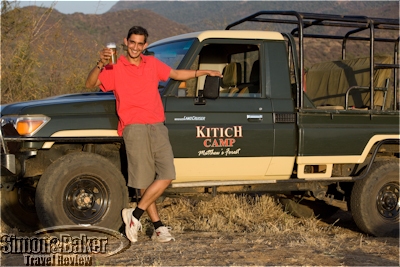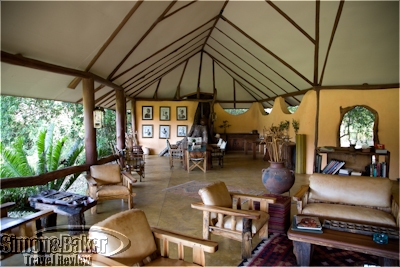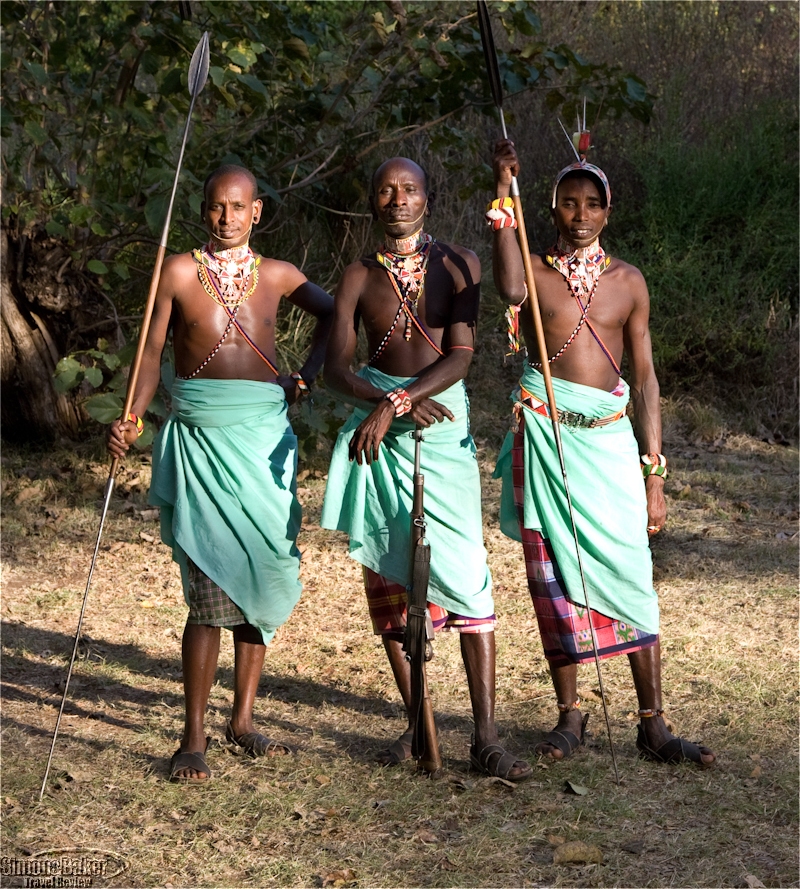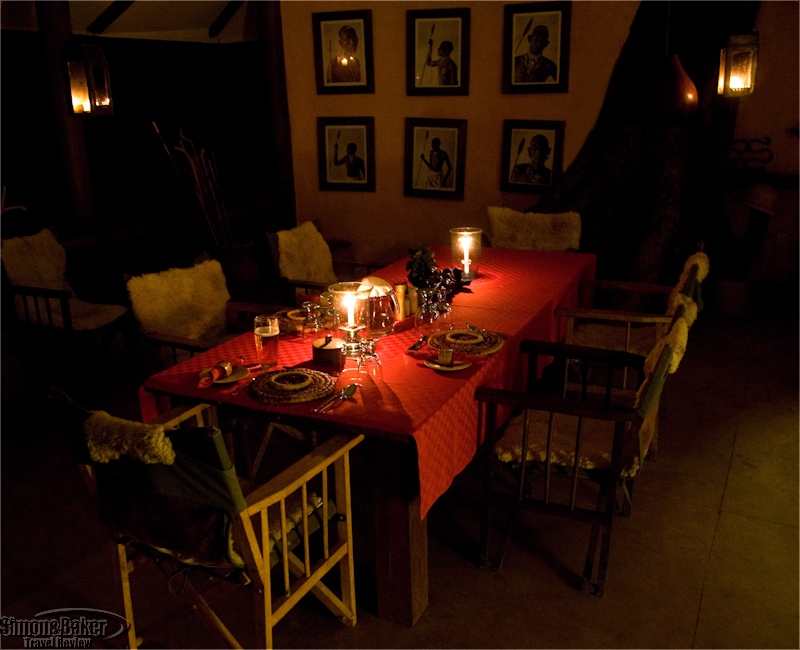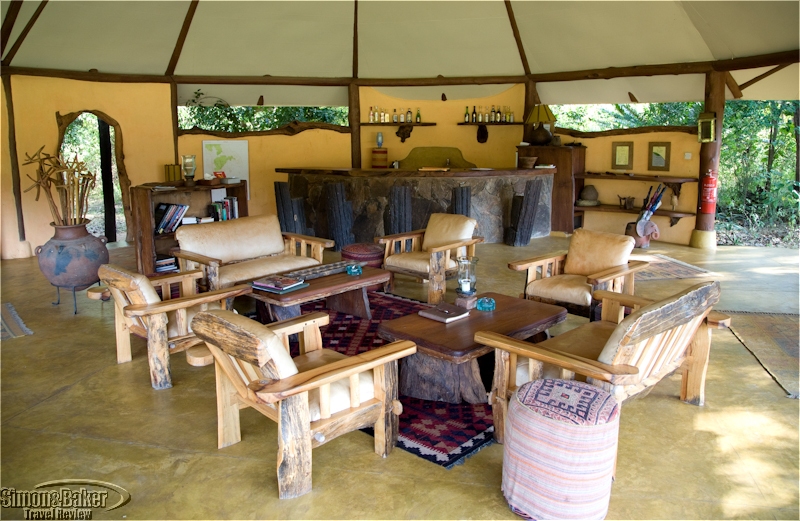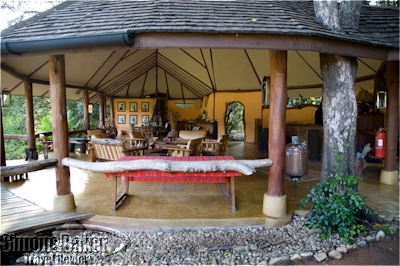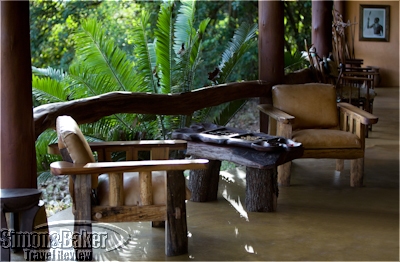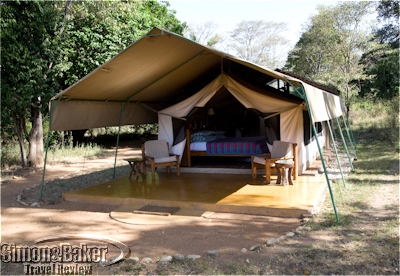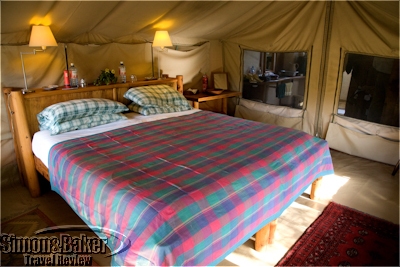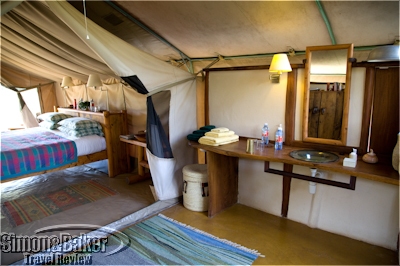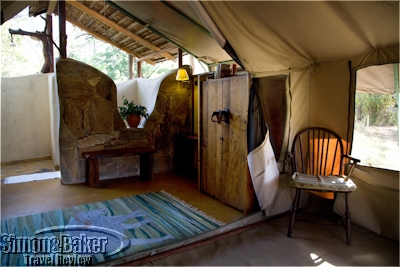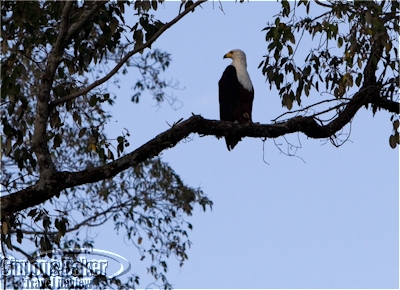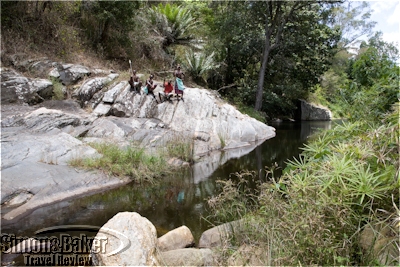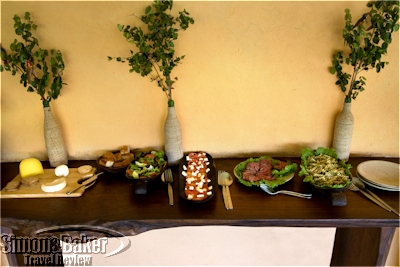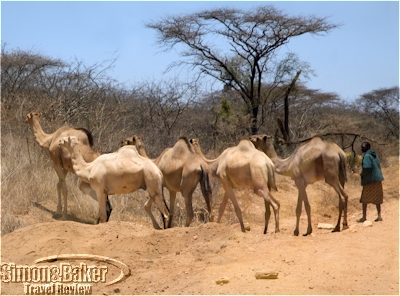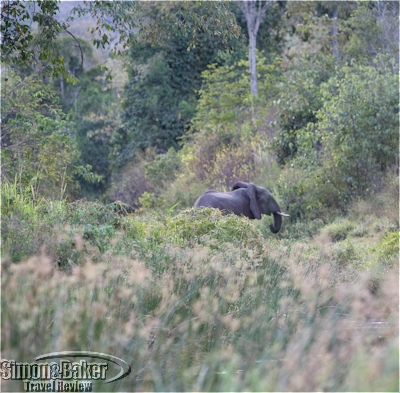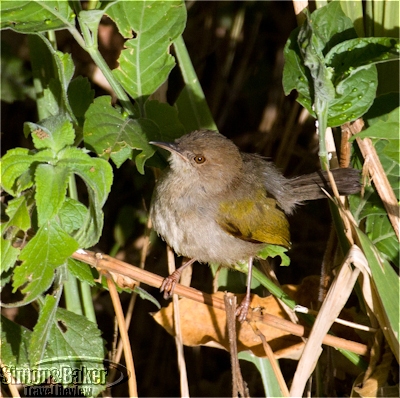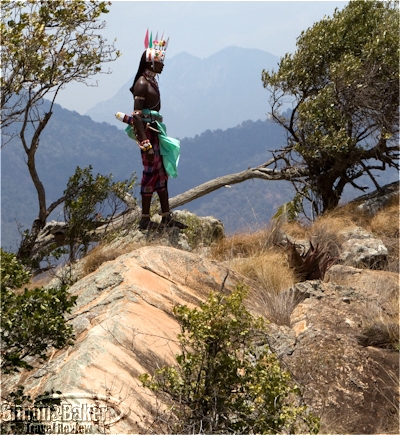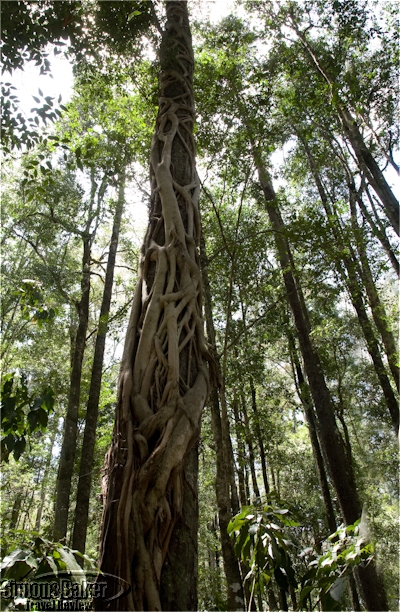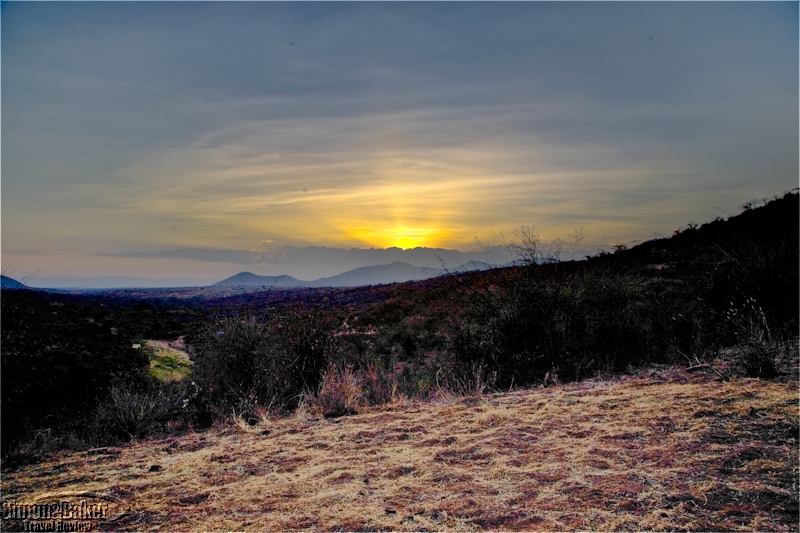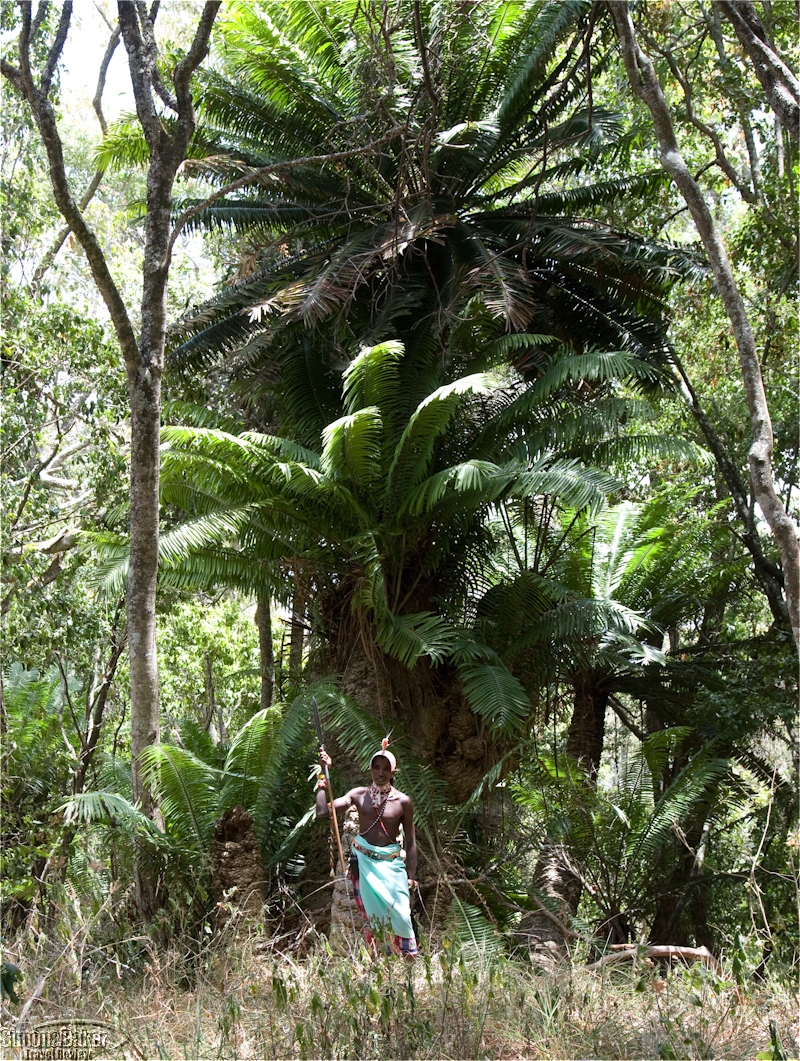
- Overall Impression
- Details
- Common Areas
- Accomodate
- Bathroom
- Dining
- Features
- Wildlife
- Activities
- Other
- Review
The drive from the airstrip to the camp took a long four hours, some of it on rough four-wheel drive roads. This drive gave us a chance to enjoy the Kenyan countryside and provided us our first glimpse of the Samburu culture as we rolled along. We passed tiny Samburu villages dotted amid the interesting scenery. Tribal men tended their livestock along the roadside. We stopped in the minute village of Wamba to buy gasoline for our vehicle and the camp.
The remote camp, nestled in the heavily forested Mathews Mountain Range, was clean and inviting. Smoothly finished concrete platforms provided the base for common areas and guest tents. The furnishings had rough hewn edges by design, lending a rustic, traditional African feeling to the property.
Kitich means “happiness” in Samburu and suited our experience at the camp. Because the camp sits at an elevation of 5500 feet nights and mornings were cool enough to require wearing sweaters or a jacket although during the heat of the day the temperatures were still comfortable. Seemingly, the altitude and placement of the camp meant minimal insect presence.
The staff members at Kitich Camp were attentive, thoughtful and detail oriented. For example, after a hike one day, we returned to our tent to find a red feather on our bed. Our walk had featured this bird species just before our return to camp.
Fresh food with an emphasis on lighter fare during the day kept us ready for the walking safari experiences that are the specialty of the camp. Nearly untouched by civilization, the terrain was too rough for game drives other than the main roads, but foot trails covered the area.
After a long walk, a hot bucket shower refreshed us to prepare for dinner with full table service, which was longer and more relaxed than lunch. A night’s sleep to the sounds of the bush prepared us for the next day.
Class Of Accommodation Luxury oriented tented camp
Connectivity The camp office had a free wireless Internet connection available for guests. The satellite-based connection allowed moderate connection speeds, slower than DSL and faster than dial-up. Cell phones could not find a signal.
General Manager Jamie Cocker was the acting manager during our stay. Patrick and Meriem Simkin were the full time managers.
Handicapped Access Yes. They have accommodated disabled people in the past. However, walking trails were not physical disabilities friendly. This camp’s focus was on walking safari experiences.
Length Of Stay Three nights
Location In the Mathews Mountain Range in Kenya, Kitich Camp is over two hundred miles north and east of Nairobi. It took us just over an hour’s flight from Nairobi followed by a four-hour drive to reach the camp.
Managed Cheli & Peacock
Owned Liz and Stefano Cheli
Size The camp occupied 25 square kilometers within the 800,000 acre Namunyak Conservancy. There were six tents as well as 17 staff and two guides.
Year Opened-Renovated Founded in the 1970s, the camp reopened in 2009 and renovated in 2010.
The main reception served as a general purpose gathering and relaxation common area for the camp. A small collection of books occupied the shelves and a bar supplied refreshment. Centrally located in the room, a sitting area anchored the space. With four chairs and two loveseats, most of the camp guests could share their daily adventures while enjoying a drink before dinner. A long table at one side of the room provided communal dining space. On the wall by the dining table hung six stunning professionally taken black and white photographs of different Samburu guides wearing their tribal costumes. The wall contained the trunk of a tree, adding natural texture to the setting.
A vibrant rug of magentas, blues and tans splashed the main tent with color. Several other woven rugs dotted the floor. A tablecloth in the traditional red plaid worn by the Maasai people covered a long table used to serve coffee, tea and snacks.
Built of white stucco and timber beams, the vaulted ceiling of the common gathering area lent architectural interest to the building. Gnarled wooden branches formed an archway for the staff members to enter from the service area.
Our standard tent measured 15 feet by 40 feet (600 square feet). Zippered openings formed the front entrance and the connection to the bathroom area. A large smooth concrete slab supported the entire tent and a roomy patio in front of the tent. The sleeping area had canvas walls, ceiling and floor. Vibrant ethnic rugs graced the floors, providing a surface to step onto in the chill of the morning.
Cotton linens with a cozy cotton duvet cover in a bright pastel plaid covered our comfortable king-sized bed. Each of us had two foam pillows. The soft and inviting bedding kept us warm during the chilly mountain nights. The headboard contained two lights, one for each person, with easy to find on-off switches. The staff left bottled water on the headboard at turndown.
The tented portion of our room featured screened windows on all sides, so we could open or close the solid flaps depending on the temperature at night and not have to worry about mosquitoes. We left some of them uncovered to enjoy the sounds of Africa at night. Roaring lions, yipping hyenas and on one exciting night, two buffalo fighting a duel provided late night entertainment in the bush.
Battery powered LED lighting recharged by solar power lit our room. Electric lighting was available twenty-four hours per day in our room.
A beautiful glass bowl sink was recessed into a wooden counter beside the clothing cupboard. A small door to the outside positioned just above the counter allowed camp workers to bring hot water to us for washing, without ever entering the tent. The morning wake up call each day included a bucket of heated water to wash up before heading out.
Items placed into a large basket of classic African design sitting below the counter would return laundered the following day. Out of respect for the all male staff and their local culture, laundry service excluded women’s undergarments. Visitors could hand wash these items with the laundry soap supplied by the camp.
Hot water limits meant bucket showers and no bathtubs. An inlaid stone floor in the concrete pad formed the shower which had no enclosure. Walls around the bathroom kept the space private; visitors taller than five foot five could easily see out. A wooden plank roof covered the entire bathroom area. On request, the staff brought a large bucket of hot water and placed it above the shower enclosure with a pipe feeding the showerhead mounted on a gnarled branch. We never needed a full bucket to take a refreshing shower. We found the water temperature suited for our needs.
The private area opposite the wall contained a pit toilet with a seat and a lid. The staff used lime each day to control the odor throughout our visit.
Meal times floated based on walks and game drives, but breakfast was typically at 7 a.m., lunch between 1 and 3 in the afternoon, and dinner between 7 p.m. and 8 p.m. Complimentary drinks included wine and beer and some liquor, with a surcharge for premium brands. Meals were served in the main reception area with a bar, a dining table, lounge seating and a wooden deck with an overlook. We ate at the large table in this location with other guests. Lunch and breakfast consisted of a small buffet and drinks served by the staff. For breakfast, we were able to order a hot plate of eggs, bacon, sausage and toast. Staff served dinners at the table.
Some of the items on offer while we were there were: for afternoon tea, hot beverages and chocolate cake with white icing; as sundowners there were beverages and snacks; for breakfast: fresh fruit (bananas, passion fruit, pineapple, papaya, cantaloupe), yogurt, three different dried cereals, milk, fresh passion juice, scrambled eggs on toast, sausage, bacon, and baked tomato. For lunch there was an excellent tomato pasta, vegetable quiche, fresh garden salad from the camp’s own garden, tuna and anchovy salad, homemade bread, and fresh passion juice. At dinner we sampled pork chops, rhubarb fruit desert, steamed broccoli, rice, and steamed snap peas. For our first dinner, we enjoyed a frozen desert called Bonifee Pie (there was a solar freezer). Another night, there was cream of vegetable soup with homemade rolls, baked chicken, cubed baked potatoes with gravy, steamed cauliflower and broccoli, and chocolate mousse for dessert. Water, wine, beer tea and coffee were on offer at meals and sundowners.
Facilities Reception and dining tents.
The birds we saw: Egyptian goose, fish eagle, paradise flycatcher (white phased), grey-headed bushshrike, white-browed robin-chat, superb starling, and cinnamon chested beat eater.
We heard male lions roaring two out of three nights, and hyenas yipping and giggling every night.
We took part in three bush walks through the forest. We found three separate groups of elephants on our first walk and thanks to the bush skills of our four Samburu guides we tracked these elephants on foot and approached close to them. Our guides taught us about wind direction and elephant habits, heightening our experience. The thick brush obscured our view of these huge creatures, but we caught glimpses of them and heard cracking tree branches nearby. Although the forest elephants in this region shy away from humans we managed to approach within a hundred yards of them.
The next morning, three guides led us up a trail on the side of the mountain. The occasionally challenging trail led to a rocky escarpment at the top. One guide led the group, carrying a rifle and keeping an eye out for any aggressive creatures occupying the trail ahead of us. Another guide walked at the back, carrying bottled water. The trail challenged us at times. The guides kept a constant vigil for our comfort, inviting us to rest periodically. Thick, dry brush gave way to tall forest trees, towering over our heads, creating a dark canopy from above.
Large butterflies floated on the wind under the canopy like bubbles blown through a wand, creating iridescent spots of vibrant color on the breeze. We saw ancient cycad plants, alive since the age of the dinosaurs, in the Mathews Mountain Range. At the top of the mountain, a rocky escarpment awaited us. The view from the lookout point made the climb worth every minute. Bringing along our hiking shoes proved fortunate to experience this journey in the remote Kenyan mountains.
The trail on our third walk involved less physical effort. The path meandered between tall forest trees, open glades and short brush. We took in the beautiful sights and sounds of the African forest and examined scat and tracks of leopard, hyena, porcupine and even honey badger.
Our guides explained that signs of rain coming soon were visible all around. The tracks of army ants, seemingly with no beginning or end, meandered back and forth across the trail; their movement signaling preparation for the coming water. The bright magenta of the fire ball lilly in bloom also presaged the coming rainy season. Fortunately the cobalt blue skies remained clear and we enjoyed sunshine.
The trail ended at a beautiful pool of water surrounded by huge, smooth boulders and forest. We took a welcome break and removed our shoes for a foot-soak in the crisp water. The trail looped around and we slowly headed back to camp, taking in the wonders of the forest around us.
We took part in one short game drive, ending in a sundowner. The comfortable four-wheel drive Toyota had openings in the sides and roof to allow less hindered game viewing. The well-preserved truck had a capacity of six, although we were alone on our drive.
The following individuals escorted us on our game drive, bush walks, and cultural visits: Jamie Cocker, a translator named Lamario, a warrior named Taustan, an elder named Lasamano, and a senior elder named Thomas Lolokuri, our tracker and guide.
Samburu men become warriors when they come of age. They retire from the warrior positions on reaching their early to mid-thirties and become elders. The Samburu had a quiet, patient and gentle nature. Ou escorts and guides were knowledgeable, competent and friendly, with typical guide experience of five to ten years. Thomas carried a rifle, Tautson and Lamario each carried a spear. The staff was helpful and explained what we saw during our activities.
Before each activity, the guides gave us safety instructions. Drives and bush walks occurred during early mornings and late afternoons. Our first walk was five hours long. Our game drive was forty five minutes of driving, but lasted two and a half hours with a sun downer stop. During activities, the guides offered us water, wine, sodas, beer, juices, and snack food including a local variety of chips and peanuts.
The camp had a well that supplied water and bottled water for drinking. Staff supplied us with bottled water for personal needs in the tent and advised against drinking or brushing teeth with the local well water.
Winner of the 2011/12 Silver Eco-rating Certification from Ecotourism Kenya Kitich Camp was created to conserve and protect the Mathews Mountain Range, an area outside the Kenyan safari tourist circuit. At the time of our visit, the Samburu and Ndorobo tribes received direct income from the camp. Through this relationship with the camp and the conservancy the local communities were meant to benefit and become materially involved in the success of the camp and related conservation efforts.
The Namunyak Conservancy, formed in 1995, covers 800,000 acres and includes thirteen trustees with a mandate to preserve wildlife and the ecosystem with a network of rangers, by resolving grazing conflicts, and through community development. Kitich Camp provided financial support and active participation in the Namanyak Conservancy.
Kitich Camp hired 100 percent of its casual staff and 90 percent of its permanent staff from the regional village of Ngilai. Located in an area of few career opportunities, jobs at Kitich Camp were highly sought after by the local people, we were told. Conservancy funds from Kitich have funded 188 secondary school and 30 university bursaries, along with assistance for 20 emergency hospital payments, one school matron’s salary for a year, 48 desks, 13 tables, and 10 chairs made by a regional carpenter.
We got the impression that Kitich Camp helped the local Samburu people understand the value of living in harmony with the wild animals around them. Kitich Camp was set up to help the local people benefit from the success of the conservation efforts in the region by providing employment and the opportunity to participate in the resulting revenue.
The camp was 100 percent powered by a green solar-energy system. The Kitich garden, which provided fresh vegetables for meals, followed sustainable practices.
Date Of Visit September 2012
Reviewers Article and Photographs by Chester Godsy and Joni Johnson-Godsy
Service Excellent. When we left the room for activities and meals, staff would tidy up and service the room. Twice a day, staff brought fresh hot water for the sink and they brought fresh shower water on request.
Lamario and Jamie spoke the best English and interacted with us during our stay. Lamario’s father sent him away to be educated when he was young and he returned to the Samburu after completing his education.
As usual in tented camps, night guard escorts took us between the common areas and our tent after dark. We never waited long when ready to go back and forth.
Would You Stay Again? Yes
Contact Information
- Mathews Mountain Range
- Cheli & Peacock
- P.O. Box 743
- 00517 Uhuru Gardens
- Nairobi, Kenya
- +254 (0)20 6003090/1
- +254 (0)20 6004050
